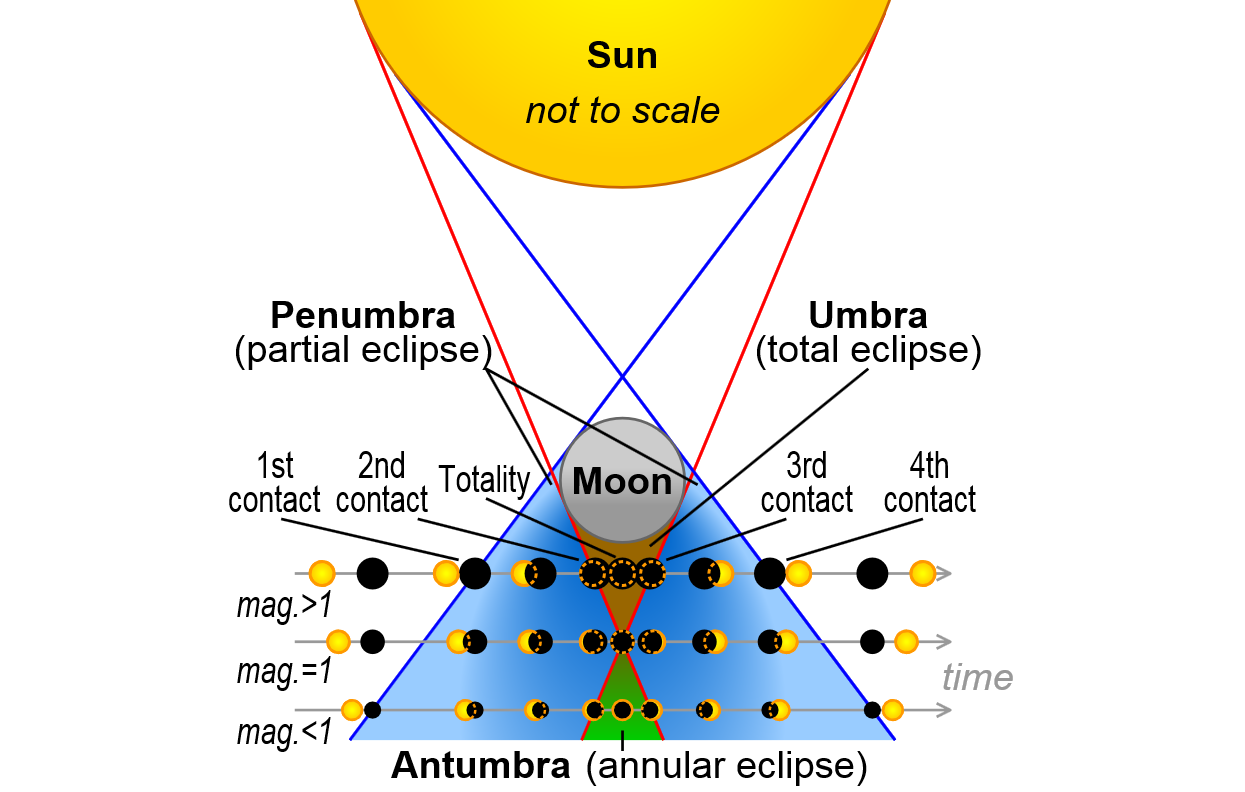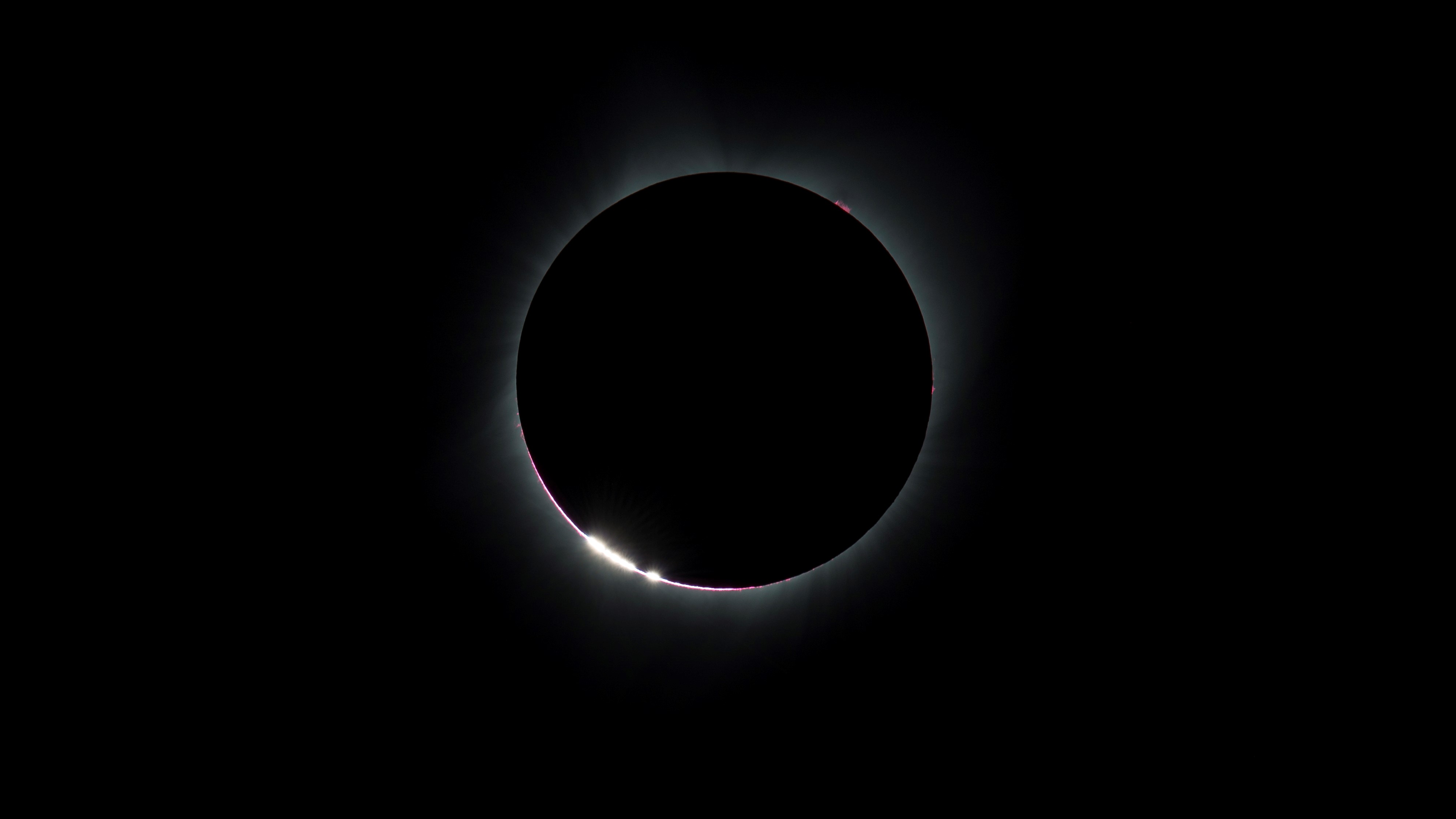Hybrid solar eclipse: Everything you need to know about the rare and strange phenomenon
Hybrid solar eclipses occur just once every decade — and there's one coming in 2023.

A hybrid solar eclipse is a very rare and strange astronomical event.
Talk to most eclipse-chasers and they'll tell you that there are three types of solar eclipse. The first is a partial eclipse of the most common and the least impressive because the moon merely blocks out part of the sun sending a shadow — the penumbra — across a swathe of Earth. The second is an annular solar eclipse, where the moon blocks out the center of the sun, but leaves a circle of light from the sun visible from within a shadow called the antumbra. It's often called a "ring of fire". The third is a total solar eclipse where the entirety of the sun's disc is blocked by the moon, revealing the spectacular sight of the solar corona, which can be viewed with the naked eye from within the moon's dark shadow, the umbra.
However, there is an intriguing fourth type of solar eclipse — a hybrid solar eclipse — that occurs only a few times per century. It's a combination of the other three types yet it's also impossible to experience in all its glory. Here's everything you need to know about a hybrid solar eclipse — the rarest, most intriguing, and arguably the most globally spectacular and interesting type of solar eclipse there is.
Related: Solar eclipses: When, where & how to see them

Jamie Carter is an experienced science journalist and solar eclipse expert. He is the editor of WhenIsTheNextEclipse.com and author of A Stargazing Program For Beginners.
WHAT IS A HYBRID SOLAR ECLIPSE?
A hybrid solar eclipse combines an annular and a total solar eclipse where the former becomes the latter and then usually reverts back. Therefore, observers at different points in the eclipse path can experience different phenomena. For example, if you watch a hybrid solar eclipse at sunrise or at sunset you may see a brief "ring of fire". If you watch it at midday — so at the mid-point of the eclipse's path across the surface of Earth — you'll experience totality. It's therefore impossible to experience both an annular and a total solar eclipse during a hybrid event — you have to make a choice.
Remember, NEVER look at the sun without adequate protection. Our how to observe the sun safely guide tells you everything you need to know about safe solar observations. The guide also informs you on what solar targets you can look out for and the equipment needed to do so.
If you want to get all set up to view a solar eclipse, we have guides to the best cameras for astrophotography, and the best lenses for astrophotography. Our how to photograph a solar eclipse guide will also help you plan for your next solar-observing adventure.
WHY DO HYBRID SOLAR ECLIPSES OCCUR?
Hybrid solar eclipses occur when the moon's distance is near its limit for the umbral shadow to reach Earth and because Earth is curved. The moon is just at the right distance from Earth for the apex of its cone-shaped shadow to be slightly above the Earth's surface at the beginning and end of the eclipse path, causing the moon's antumbral shadow to move across Earth causing an annular solar eclipse. However, in the middle of the eclipse path, the apex of the moon's umbral shadow strikes Earth's surface because that part of the planet is slightly closer to the moon.

This diagram of a hybrid solar eclipse shows how the moon's distance from the Earth determines the shadow projected onto the Earth's surface, from the faint penumbra of a partial solar eclipse to the deep, dark umbra of totality and the antumbra — a kind of half-shadow — of annularity.
WHEN IS THE NEXT HYBRID SOLAR ECLIPSE?
The next hybrid solar eclipse will occur on Friday, Nov. 14, 2031, according to Time and Date.
At least a partial eclipse will be visible across parts of North America, North/West South America, Pacific, Atlantic.
If you want to see the path of the eclipse, along with the eclipse timings for each location, check out this interactive eclipse map by Xavier Jubier.
WHAT ARE BAILY'S BEADS?

Named after English astronomer Francis Baily, who observed them in the early 1800s, Baily's beads are the last rays of sunlight that can be seen streaming through the valleys of the moon just before totality. They can also be seen as totality ends. During a hybrid solar eclipse, the displays of Baily's beads are longer because the moon is almost precisely the same apparent size as the sun.
HOW OFTEN DOES A HYBRID SOLAR ECLIPSE HAPPEN?
There are between two and five solar eclipses each year, though during the 21st century just 3.1% (7 out of 224) of solar eclipses are hybrid solar eclipses. Between 2000 BCE to 3000 CE just 4.8% of solar eclipses are hybrid events.
The last hybrid solar eclipse to occur was on April 20, 2023. It swept over the South Pacific, with the moon's shadow passing over western Australia, East Timor and Indonesia.
Related: Rare hybrid solar eclipse 2023 delights South Pacific skywatchers (photos)
WHAT IS ANOTHER NAME FOR A HYBRID SOLAR ECLIPSE?
Hybrid solar eclipses are often called annular-total eclipses, "beaded" solar eclipses or "broken" annular eclipses, the latter two because they feature particularly long displays of Baily's beads.
Because the moon appears to pass directly in front of the sun, hybrid solar eclipses are classified as "central" solar eclipses — as are total and annular solar eclipses — to differentiate them from partial solar eclipses.
Additional resources
Explore the different types of solar eclipses in more detail with this informative NASA article. Texas State University has a useful list of several videos explaining the different types of eclipses.
Editor's Note: If you snap an amazing solar eclipse photo and would like to share it with Space.com's readers, send your photo(s), comments, and your name and location to spacephotos@space.com
Jamie Carter is the editor of WhenIsTheNextEclipse.com
Join our Space Forums to keep talking about space on the latest missions, night sky, and more! And if you have a news tip, correction, or comment, let us know at: community@space.com.
BIBLIOGRAPHY
Bikos, K. (2022, November 13). What Is a Hybrid Solar Eclipse? Retrieved November 13, 2022, from https://www.timeanddate.com/eclipse/hybrid-solar-eclipse.html
Espenak, F. (2007, February 13). Five Millenium catalog of hybrid solar eclipses. Retrieved November 13, 2022, from https://eclipse.gsfc.nasa.gov/SEcat5/SEhybrid5.html
Jubier, X. (2022, November 13). Five Millennium (-1999 to +3000) Canon of Solar Eclipses Database. Retrieved November 13, 2022, from http://xjubier.free.fr/en/site_pages/solar_eclipses/5MCSE/xSE_Five_Millennium_Canon.html
Nemiroff, R. and Bonnell, J. (November 3, 2013). Astronomy Picture of the Day. Retrieved November 13, 2022, from https://apod.nasa.gov/apod/ap131103.html
Join our Space Forums to keep talking space on the latest missions, night sky and more! And if you have a news tip, correction or comment, let us know at: community@space.com.
Get the Space.com Newsletter
Breaking space news, the latest updates on rocket launches, skywatching events and more!

Jamie is an experienced science, technology and travel journalist and stargazer who writes about exploring the night sky, solar and lunar eclipses, moon-gazing, astro-travel, astronomy and space exploration. He is the editor of WhenIsTheNextEclipse.com and author of A Stargazing Program For Beginners, and is a senior contributor at Forbes. His special skill is turning tech-babble into plain English.










